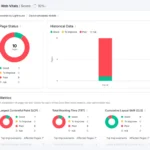
In today’s interconnected world, businesses are increasingly targeting global audiences, making multi-language websites a vital part of digital marketing. However, simply translating content is not enough. Multi-language SEO requires a strategic approach to ensure your website ranks in different countries and languages while providing a seamless user experience.
Why Multi-Language SEO Matters
- Expands Global Reach
Optimizing for multiple languages helps businesses reach audiences in different regions, improving brand visibility internationally. - Enhances User Experience
Users are more likely to engage with a website that speaks their language, increasing conversions and reducing bounce rates. - Improves Search Engine Rankings in Target Regions
Localized SEO helps search engines understand which pages to show to users in specific countries, boosting local visibility. - Builds Brand Credibility
Providing content in the native language of your audience demonstrates professionalism and cultural awareness, enhancing trust and authority.
Key Strategies for Multi-Language SEO
1. Implement Hreflang Tags
Hreflang tags tell search engines which language and region a page is targeting. This prevents duplicate content issues and ensures the right version appears in search results.
Example:
<link rel="alternate" href="https://www.example.com/fr/" hreflang="fr-fr" />
<link rel="alternate" href="https://www.example.com/en/" hreflang="en-us" />
2. Use Country-Specific Domains or Subdirectories
- Country Code Top-Level Domain (ccTLD):
example.frfor France - Subdirectories:
example.com/fr/ - Subdomains:
fr.example.com
Each approach has pros and cons regarding SEO authority, cost, and manageability.
3. Translate Content Accurately
Avoid machine translations that are literal and awkward. Use professional translators who understand local culture and idioms, ensuring content is natural and engaging.
4. Localize Keywords
Keyword search behavior varies by country and language. Conduct local keyword research to identify region-specific search terms rather than translating keywords directly.
5. Optimize Meta Tags and URLs
- Translate title tags, meta descriptions, and headings into the target language.
- Use localized URLs (e.g.,
/fr/chaussures/for French “shoes”).
6. Optimize for Local Search Engines
While Google dominates in many countries, other search engines like Bing, Baidu (China), Yandex (Russia), and Naver (Korea) are popular locally. Adjust your strategy accordingly.
7. Implement Local Backlinks
Build backlinks from relevant websites in the target region to boost authority and trust with local search engines.
8. Mobile Optimization
Mobile usage varies across regions. Ensure your website is fast, responsive, and mobile-friendly for all target audiences.
9. Structured Data and Schema Markup
Use localized schema markup to provide search engines with structured information like product prices, events, and reviews, increasing visibility in international SERPs.
10. Monitor and Analyze Performance
Use tools like Google Search Console, SEMrush, and Ahrefs to track performance in different countries and languages. Adjust strategies based on metrics like traffic, CTR, and rankings.
Our Services SEO Services in Varanasi | SEO Services in Kolkata | SEO Services in Ayodhya | SEO Services in Hajipur
Key Takeaways
- Multi-language SEO is essential for global reach, user engagement, and local search visibility.
- Proper implementation includes hreflang tags, localized content, meta tags, URLs, and backlinks.
- Monitoring performance and adjusting strategies ensures continued growth and SEO success across regions.
FAQs About Multi-Language SEO (Unique)
1. Should I use the same content for multiple languages?
No. Duplicate content across languages can confuse search engines. Always translate and localize content to match cultural and linguistic preferences.
2. How do hreflang tags help with duplicate content?
Hreflang tags tell search engines which version of a page belongs to which region/language, preventing them from treating translations as duplicate content.
3. Can I target multiple regions with the same language?
Yes. For example, English content can target the US, UK, Canada, and Australia. Use hreflang attributes like en-us, en-gb, and en-ca to specify regions.
4. How important is local keyword research for multi-language SEO?
Extremely important. Translating keywords literally may not reflect local search behavior. Conduct research in each target region to identify high-volume, relevant terms.
5. Should I build separate backlinks for each language version?
Yes. Backlinks from region-specific domains or authoritative local sites strengthen SEO performance for that target country.
6. Can machine translation tools work for multi-language SEO?
Machine translation can help as a draft, but human review and localization are essential to maintain quality and natural language, which influences SEO rankings.
7. How do I handle technical SEO for multi-language websites?
Ensure each language version has its own sitemap, structured data, proper canonical tags, and server performance optimization for better indexing and ranking.
Conclusion
Multi-language SEO is a strategic approach for global growth. By implementing hreflang tags, localizing keywords, translating content accurately, and optimizing technical SEO elements, businesses can reach international audiences, improve search visibility, and drive engagement worldwide.
Effective multi-language SEO combines technical best practices, cultural awareness, and continuous monitoring to ensure your website ranks and converts across multiple countries.





